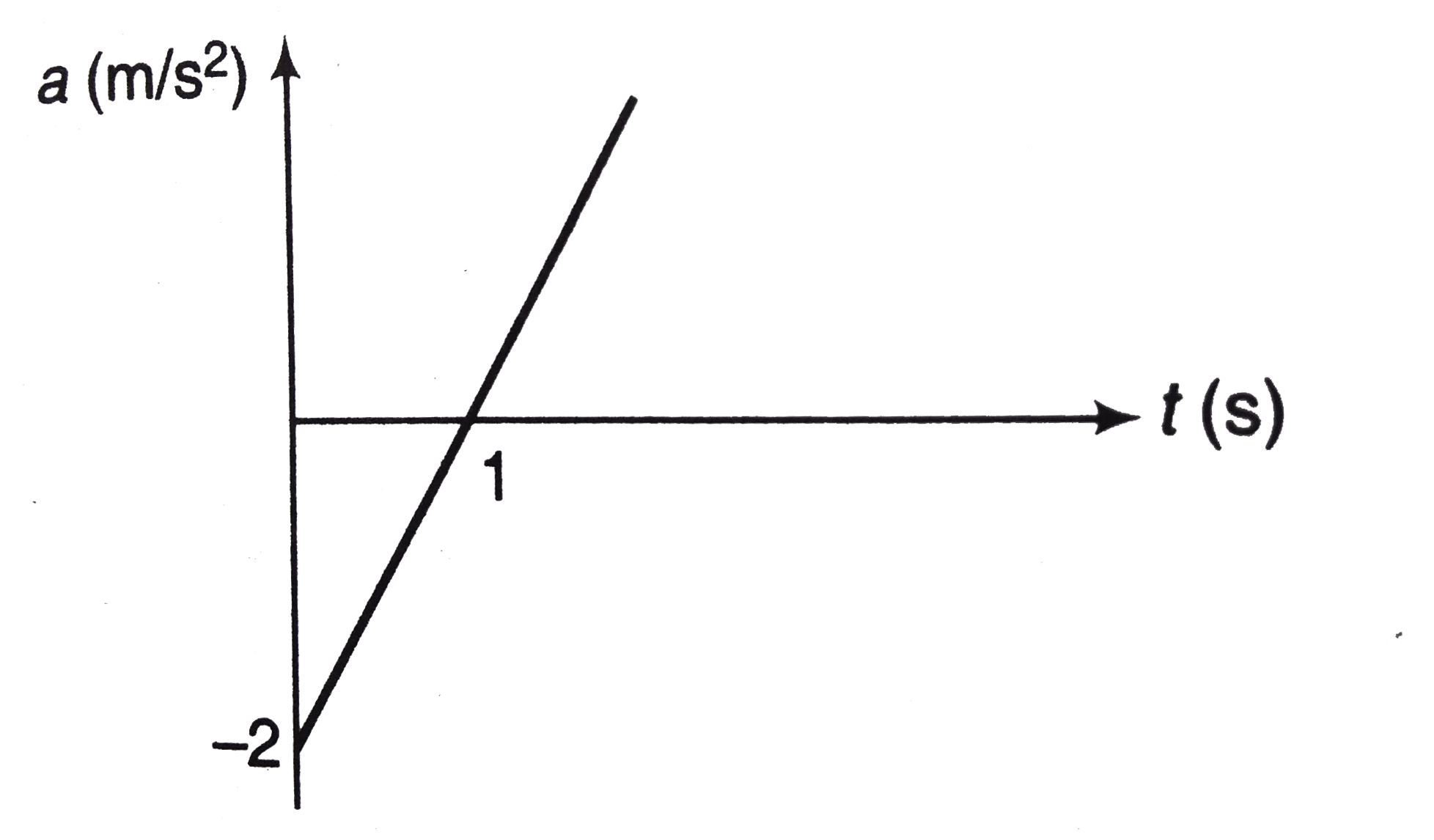Position vector of a particle varies with time t accordin to the law , where r is in meters and t is in seconds.
(a) Find suitable expression for its velocity and acceleration as function of time (b) Find magnitude of its displacement and distance traveled in the time interval to .
To solve the problem step by step, we will break it down into parts (a) and (b) as per the question.
Part (a): Finding Velocity and Acceleration
1. Given Position Vector:
The position vector of the particle is given by:
→r(t)=12t2^i−43t1.5^j+2t^k
2. Finding Velocity:
Velocity →v(t) is the derivative of the position vector →r(t) with respect to time t:
→v(t)=d→rdt=ddt(12t2^i−43t1.5^j+2t^k)
- Differentiate each component:
- For ^i component: ddt(12t2)=t
- For ^j component: ddt(−43t1.5)=−2t0.5
- For ^k component: ddt(2t)=2
Thus, the velocity vector is:
→v(t)=t^i−2t0.5^j+2^k
3. Finding Acceleration:
Acceleration →a(t) is the derivative of the velocity vector →v(t) with respect to time t:
→a(t)=d→vdt=ddt(t^i−2t0.5^j+2^k)
- Differentiate each component:
- For ^i component: ddt(t)=1
- For ^j component: ddt(−2t0.5)=−t−0.5
- For ^k component: ddt(2)=0
Thus, the acceleration vector is:
→a(t)=1^i−t−0.5^j
Part (b): Finding Displacement and Distance Traveled
1. Finding Displacement:
Displacement is the change in position vector from t=0 to t=4.
- Calculate →r(0):
→r(0)=12(0)2^i−43(0)1.5^j+2(0)^k=0^i+0^j+0^k=→0
- Calculate →r(4):
→r(4)=12(42)^i−43(41.5)^j+2(4)^k
=8^i−43(8)^j+8^k=8^i−323^j+8^k
- Therefore, the displacement vector Δ→r is:
Δ→r=→r(4)−→r(0)=(8^i−323^j+8^k)−→0=8^i−323^j+8^k
2. Magnitude of Displacement:
The magnitude of the displacement vector is given by:
|Δ→r|=√(8)2+(−323)2+(8)2
=√64+10249+64=√128+10249=√1152+10249=√21769=√21763
≈15.5 m
3. Finding Distance Traveled:
To find the distance traveled, we need to integrate the magnitude of the velocity from t=0 to t=4:
Distance=∫40|→v(t)|dt
- Calculate the magnitude of velocity:
|→v(t)|=√(t)2+(−2t0.5)2+(2)2=√t2+4t+4=√(t+2)2=|t+2|
- Since t is from 0 to 4, t+2 is always positive:
Distance=∫40(t+2)dt=(t22+2t)40=(162+8)−0=8+8=16 m
Summary of Results
- Velocity: →v(t)=t^i−2t0.5^j+2^k
- Acceleration: →a(t)=1^i−t−0.5^j
- Magnitude of Displacement: ≈15.5 m
- Distance Traveled: 16 m
The position vector of the particle is given by:
→r(t)=12t2^i−43t1.5^j+2t^k
Velocity →v(t) is the derivative of the position vector →r(t) with respect to time t:
→v(t)=d→rdt=ddt(12t2^i−43t1.5^j+2t^k)
- Differentiate each component:
- For ^i component: ddt(12t2)=t
- For ^j component: ddt(−43t1.5)=−2t0.5
- For ^k component: ddt(2t)=2
→v(t)=t^i−2t0.5^j+2^k
Acceleration →a(t) is the derivative of the velocity vector →v(t) with respect to time t:
→a(t)=d→vdt=ddt(t^i−2t0.5^j+2^k)
- Differentiate each component:
- For ^i component: ddt(t)=1
- For ^j component: ddt(−2t0.5)=−t−0.5
- For ^k component: ddt(2)=0
→a(t)=1^i−t−0.5^j
Displacement is the change in position vector from t=0 to t=4.
- Calculate →r(0):
→r(0)=12(0)2^i−43(0)1.5^j+2(0)^k=0^i+0^j+0^k=→0
- Calculate →r(4):
→r(4)=12(42)^i−43(41.5)^j+2(4)^k
=8^i−43(8)^j+8^k=8^i−323^j+8^k
- Therefore, the displacement vector Δ→r is:
Δ→r=→r(4)−→r(0)=(8^i−323^j+8^k)−→0=8^i−323^j+8^k
The magnitude of the displacement vector is given by:
|Δ→r|=√(8)2+(−323)2+(8)2
=√64+10249+64=√128+10249=√1152+10249=√21769=√21763
≈15.5 m
To find the distance traveled, we need to integrate the magnitude of the velocity from t=0 to t=4:
Distance=∫40|→v(t)|dt
- Calculate the magnitude of velocity:
|→v(t)|=√(t)2+(−2t0.5)2+(2)2=√t2+4t+4=√(t+2)2=|t+2|
- Since t is from 0 to 4, t+2 is always positive:
Distance=∫40(t+2)dt=(t22+2t)40=(162+8)−0=8+8=16 m
- Velocity: →v(t)=t^i−2t0.5^j+2^k
- Acceleration: →a(t)=1^i−t−0.5^j
- Magnitude of Displacement: ≈15.5 m
- Distance Traveled: 16 m
Topper's Solved these Questions
- BOOK - ALLENCHAPTER - KINEMATICSEXERCISE - EXERCISE-0155videos
KINEMATICS
- BOOK - ALLENCHAPTER - KINEMATICSEXERCISE - EXERCISE-0257videos
KINEMATICS
- BOOK - ALLENCHAPTER - ERROR AND MEASUREMENTEXERCISE - Part-2(Exercise-2)(B)22videos
ERROR AND MEASUREMENT
- BOOK - ALLENCHAPTER - KINEMATICS (MOTION ALONG A STRAIGHT LINE AND MOTION IN A PLANE)EXERCISE - BEGINNER S BOX-78videos
KINEMATICS (MOTION ALONG A STRAIGHT LINE AND MOTION IN A PLANE)
Similar Questions
Knowledge Check
- Question 1 - Select One or More
Position vector of a particle is expressed as function of time by equation →r=2t2+(3t−1)ˆj+5ˆk. Where r is in meters and t is in seconds.
AIt always moves in a plane that is parallel to the x-y plane.BAt the instant t=0 s, it is observed at point (0m, -1m, 5m), moving with velocity 3 m/s in the positive y-direction.CIts acceleration vector is uniform.DIt is an example of three dimensional motion. - Question 2 - Select One or More
Velocity of a particle moving in a curvilinear path varies with time as v=(2tˆi+t2ˆk)m/s. Here t is in second. At t=1 s
Aacceleration of particle is 8m/s2Btangential acceleration of particle is 6√5m/s2Cradial acceleration of particle is 2√5m/s2Dradius of curvature to the path is 5√52m - Question 3 - Select One or More
A particle is moving with a position vector, →r=[a0sin(2πt)ˆi+a0cos(2πt)ˆj]. Then -
AMagnitude of displacement of the particle between time t=4 sec and t=6 sec is zeroBDistance travelled by the particle in 1 sec is 2πa0CThe speed of particle in the whole motion is constant and equal to 2πa0.Dnone of these
A particle is moving along the x-axis such that s=6t−t2, where s in meters and t is in second. Find the displacement and distance traveled by the particle during time interval t=0 to t=5s.
View SolutionThe acceleration of particle varies with time as shown.

(a) Find an expression for velocity in terms of t.
(b) Calculate the displacement of the particle in the interval from t=2s to t=4s. Assume that v=0 at t=0.View SolutionA particle moves along the space curve →r=(t2+t)ˆi+(3t−2)ˆj+(2t3−4t2)ˆk. (t in sec, r in m ) Find at time t=2 the (a) velocity, (b) acceleration, (c) speed or magnitude of velocity and (d) magnitude of acceleration.
View SolutionThe position vector →r of a moving particle at time t after the start of the motion is given by →r=(5+20t)ˆi+(95+10t−5t2)ˆj. At the t = T, the particle is moving at right angles to its initial direction of motion. Find the value of T and the distance of the particle from its initial position at this time.
View SolutionThe position vector of a particle moving in x-y plane is given by →r=(t2−4)ˆi+(t−4)ˆj. Find
(a) Equation of trajectory of the particle
(b)Time when it crosses x-axis and y-axisView Solution

